The best carbon-sequestering plants for living boundaries include oak trees (48 pounds CO₂ annually), Leyland Cypress, and Eastern Red Cedar for year-round capture. You’ll get excellent results with drought-tolerant junipers, fast-growing Green Giant Arborvitae, and nitrogen-fixing clovers. Consider multi-layered combinations of willows with native grasses for maximum impact. Don’t overlook fruit-bearing options like apple trees and blueberry shrubs, which offer carbon storage plus edible rewards. Discover how these powerhouse plants can transform your property while fighting climate change.
Native Trees With Deep Root Systems for Maximum Carbon Storage
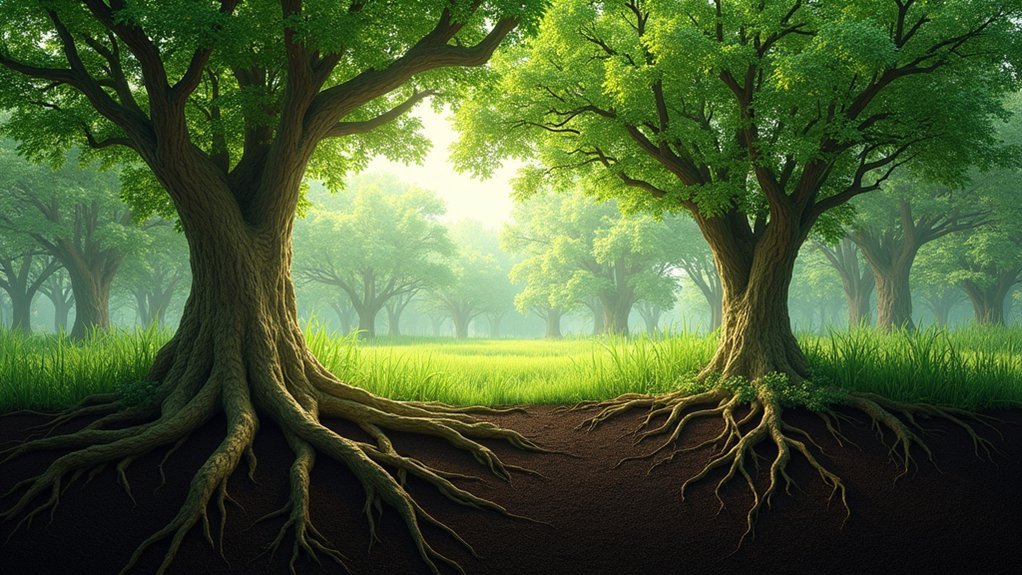
When seeking to maximize carbon sequestration in your landscape, native trees with extensive root systems offer the most powerful natural solution.
Oak species stand out as carbon champions, with mature specimens capturing approximately 48 pounds of CO₂ annually. Their deep root structures enhance their carbon-storing capacity while improving soil health.
For effective trees for carbon sequestration, consider Black Walnut and Red Maple, which thrive locally and feature robust root networks that excel at carbon retention in soil.
If you’re looking for quicker results, Eastern Cottonwood establishes rapidly, sequestering significant carbon during early growth phases.
For ideal impact, plant a diverse mixture of native species with varying root depths.
This approach not only maximizes carbon storage but also creates valuable wildlife habitat, supporting the broader ecosystem while fighting climate change.
Fast-Growing Hedge Species for Rapid Carbon Sequestration
While large trees offer substantial carbon storage over time, fast-growing hedge species provide an excellent alternative for those seeking quicker climate impact.
Leyland Cypress stands out as a carbon champion, sequestering approximately 48 pounds of CO₂ annually when mature.
You’ll find Privet establishes quickly, creating dense foliage that supports wildlife while capturing carbon effectively.
For impressive results, consider Green Giant Arborvitae, which grows up to 3 feet yearly, rapidly developing into a substantial carbon sink.
Don’t overlook native options like Eastern Red Cedar, which thrives in various soil conditions while enhancing local biodiversity.
The key advantage of these fast-growing hedge species is their establishment period of just 1-3 years, accelerating carbon sequestration compared to traditional trees that require a decade or more to mature.
Evergreen Shrubs That Sequester Carbon Year-Round

You’ll appreciate evergreen shrubs not just for creating living privacy screens, but also for their remarkable ability to capture carbon throughout all seasons.
Holly and boxwood stand out as winter carbon retention champions, continuing photosynthesis when deciduous plants have shed their leaves.
For drought-prone regions, consider native evergreens like juniper or manzanita that offer excellent boundary solutions while maintaining carbon sequestration even during water-restricted periods.
Ideal Privacy Hedge Choices
Creating a living boundary around your property serves dual purposes when you select carbon-sequestering evergreen shrubs.
Eastern Red Cedar excels as a privacy hedge with its dense foliage that captures carbon year-round through extensive root systems.
For rapid carbon sequestration, consider Leyland Cypress, which absorbs 40-60 pounds of CO2 annually while quickly establishing privacy barriers.
Arborvitae varieties offer similar benefits, with mature plants capturing 30-50 pounds of CO2 each year.
Don’t overlook Boxwood for its compact, dense growth habit that effectively stores carbon in urban settings.
If you’re aiming for substantial height, Green Giant Arborvitae reaches 30-50 feet and efficiently sequesters carbon while creating impressive privacy screens.
These strategic choices allow you to enhance property boundaries while contributing meaningfully to environmental sustainability.
Winter Carbon Retention Champions
Unlike their deciduous counterparts that shed leaves and slow carbon capture during cold months, evergreen shrubs continue sequestering carbon throughout winter, making them environmental powerhouses year-round.
Eastern Red Cedar stands out as an exceptional carbon sequestration champion, providing wildlife habitat while consistently capturing CO2.
American Holly impresses by sequestering approximately 1.8 kg of carbon dioxide annually, maintaining this crucial ecological service even during winter dormancy periods.
You’ll find Boxwood varieties particularly effective as their dense foliage photosynthesizes during mild winter days, enhancing your property’s carbon storage capacity.
The deeper root systems of these evergreen shrubs store additional carbon underground while improving soil health.
For maximum environmental impact, consider creating living boundaries with diverse evergreen species, establishing a continuous carbon sink that works diligently through all seasons while boosting local biodiversity.
Drought-Tolerant Boundary Solutions
When establishing environmental boundaries that work hard for the planet, drought-tolerant evergreen shrubs offer a double benefit: continuous carbon sequestration and remarkable water efficiency. Junipers stand out in this category, requiring minimal irrigation while storing carbon year-round through their evergreen foliage.
| Plant Species | Carbon Capture | Water Needs |
|---|---|---|
| Juniperus virginiana | 48 lbs CO₂ annually | Very Low |
| Ceanothus spp. | Significant (deep roots) | Low |
| Buxus spp. | Moderate (dense foliage) | Moderate |
For rapid carbon sequestration, consider the Leyland Cypress, which grows quickly and creates an effective living boundary. California Lilac delivers additional benefits with its nitrogen-fixing capabilities, enhancing soil health while thriving in dry conditions. These drought-tolerant options guarantee your boundary plantings contribute meaningfully to carbon storage without taxing water resources.
Indigenous Perennial Grasses for Soil Carbon Enhancement
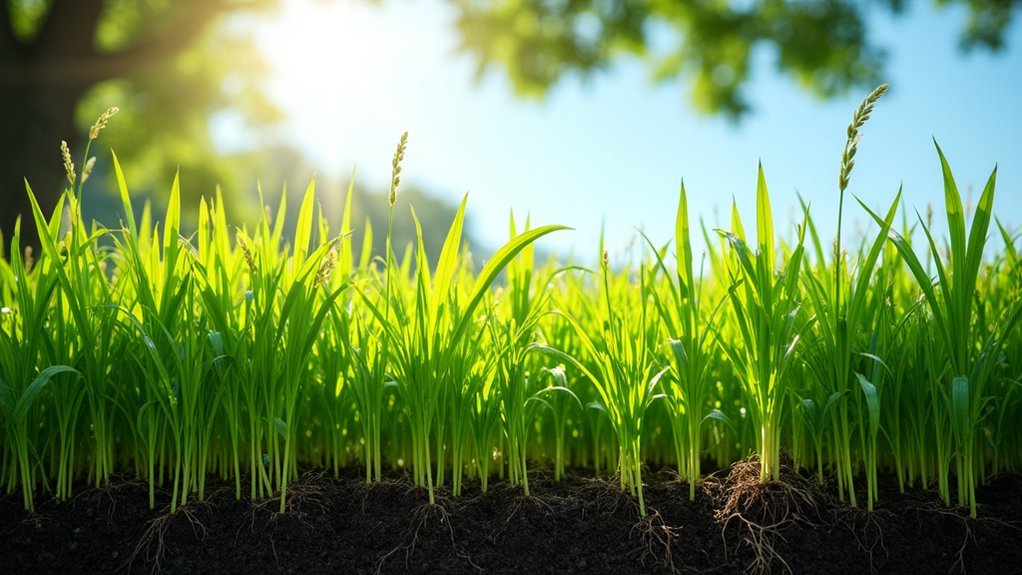
Although often overlooked in carbon sequestration discussions, indigenous perennial grasses represent some of nature’s most efficient carbon capture systems.
Indigenous perennial grasses silently outperform flashier carbon solutions, serving as nature’s own elegant sequestration technology.
Switchgrass and big bluestem feature extensive underground root networks that continuously store carbon without releasing it back into the atmosphere.
You’ll find these perennial plants can sequester up to 1.5 tons of carbon per hectare annually when properly managed. Their year-round presence enriches soil health by contributing organic matter and nutrients, creating robust carbon sinks beneath your property.
What makes these grasses particularly valuable is their drought resistance and minimal maintenance requirements compared to annual alternatives.
Nitrogen-Fixing Plants That Improve Soil and Store Carbon
Planting nitrogen-fixing legumes around your property’s boundaries creates living carbon sinks that pull double-duty in your climate-smart landscape.
You’ll boost soil health as these boundary warriors convert atmospheric nitrogen into plant-available nutrients, reducing your need for synthetic fertilizers.
Their extensive root systems simultaneously sequester carbon deep in the soil while their above-ground biomass supports beneficial insects and pollinators.
Leguminous Boundary Warriors
While many gardeners focus solely on trees for carbon capture, leguminous plants serve as remarkable boundary warriors in your carbon-sequestering arsenal.
These nitrogen-fixing champions can store approximately 1.5 tons of carbon per hectare annually while simultaneously enriching your soil naturally.
You’ll find options like clover, alfalfa, and various bean species ideal for creating living fences or hedgerows.
These leguminous plants not only establish effective windbreaks and reduce erosion but also boost local biodiversity.
Their deep root systems improve water infiltration and retention, supporting sustainable land management on your property.
Soil Carbon Double-Duty
Beyond their boundary functions, nitrogen-fixing plants perform an impressive dual role in your carbon-fighting strategy.
These botanical multi-taskers convert atmospheric nitrogen into plant-available forms while simultaneously storing carbon in their biomass and extensive root systems.
Legumes like clover and alfalfa can sequester 0.5-2.5 tons of carbon per hectare annually, making them powerhouses for soil carbon enhancement.
When you incorporate these plants into your landscape boundaries, you’re not just creating beautiful dividers—you’re building carbon reserves underground.
The benefits extend beyond carbon sequestration.
By reducing your need for synthetic fertilizers, these plants further decrease greenhouse gas emissions.
They’ll also improve your soil’s water retention and biodiversity, creating healthier ecosystems.
Your boundary plants aren’t just defining spaces—they’re actively rebuilding soil carbon with every growing season.
Multi-Layered Living Fence Combinations for Optimal Carbon Capture
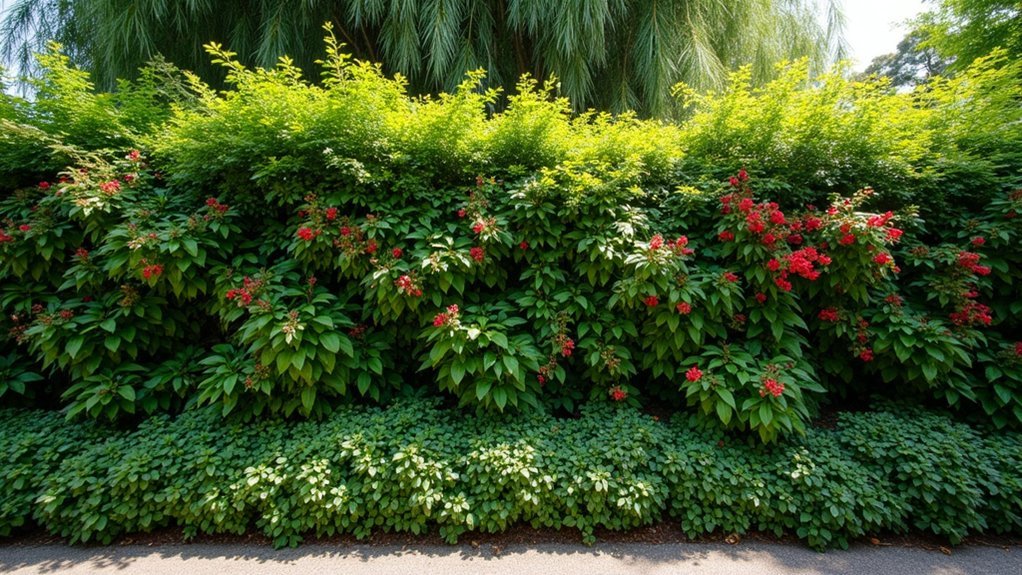
To maximize carbon capture on your property, multi-layered living fences offer a strategic solution that leverages vertical space and diverse root systems.
These living boundaries can sequester 1-4 tons of CO2 per hectare annually while supporting vital biodiversity.
- Combine fast-growing species like willows with long-lived oaks for both immediate and sustained carbon sequestration.
- Integrate deep-rooted native grasses between woody plants to increase soil carbon retention by up to 30% compared to annual plantings.
- Create vertical diversity with trees, shrubs, and perennials that utilize different growth heights for thorough carbon capture.
- Mix hedgerows with flowering species to attract pollinators, enhancing ecosystem resilience while your living fence continues storing carbon.
Climate-Resilient Boundary Plants for Changing Conditions
You’ll need boundary plants that withstand climate extremes while continuing to sequester carbon effectively.
Consider drought-tolerant barrier species like switchgrass and big bluestem that develop deep root systems for maximum carbon storage.
Heat-wave resistant hedges and flood-adapted living fences, such as native shrubs, can further enhance your property’s resilience while supporting essential ecosystem services.
Drought-Tolerant Barrier Species
While traditional landscaping often prioritizes aesthetics over function, drought-tolerant barrier species offer a powerful dual benefit: exceptional carbon sequestration and resilience against increasingly unpredictable climate conditions.
You’ll find these plants particularly valuable for creating living boundaries that work harder for your property:
- Purple Coneflower and Switchgrass establish deep root systems that enhance soil carbon storage while improving overall soil health.
- Western Red Cedar and Honeylocust sequester significant carbon while providing wildlife habitat and natural shade.
- Native grasses and shrubs create effective windbreaks and erosion controls, maximizing your property’s carbon sequestration potential.
- Drought-tolerant barrier species can reduce your water usage by up to 50%, making them both environmentally and economically beneficial.
These resilient plants create boundaries that adapt to climate challenges while capturing carbon effectively.
Heat-Wave Resistant Hedges
As temperatures continue to rise globally, strategically planted heat-wave resistant hedges offer powerful carbon-sequestering solutions while creating protective microclimates on your property.
Native species like Eastern Red Cedar and American Holly excel at carbon sequestration while providing cooling benefits during extreme heat events.
For quicker establishment, consider fast-growing options such as Privet and Boxwood, which rapidly capture carbon in their dense foliage and extensive root systems.
Incorporate drought-tolerant varieties like Butterfly Bush and Spiraea to enhance your boundary’s resilience while maximizing carbon capture through robust growth.
For areas prone to prolonged dry spells, deep-rooted perennials such as Miscanthus grass maintain soil health and carbon storage even in challenging conditions.
Creating diverse living boundaries with heat-wave resistant plants not only enhances carbon sequestration but also strengthens your landscape’s biodiversity and resilience against changing climate conditions.
Flood-Adapted Living Fences
Where excessive heat threatens landscapes, waterlogged environments present different carbon-sequestration opportunities.
You’ll find flood-adapted trees like willows and dogwoods excel in wet conditions while building resilient boundaries that protect your land.
These specialized living fences offer multiple benefits:
- Enhanced soil stability through extensive root systems that prevent erosion during flooding events
- Significant carbon storage with willows capturing up to 3.5 tons of CO2 per hectare annually
- Natural flood protection that shields agricultural areas while improving local biodiversity
- Climate resilience through strategic placement in riparian zones, maximizing carbon sequestration while maintaining water quality
Fruit-Bearing Species That Combine Carbon Storage With Food Production
Gardeners seeking to combat climate change need not choose between growing food and sequestering carbon. Fruit-bearing species offer the perfect dual-purpose solution for your living boundaries. Apple and pear trees capture approximately 48 pounds of CO₂ annually while providing delicious harvests.
| Species | Carbon Benefits | Food Benefits |
|---|---|---|
| Apple/Pear Trees | 48 lbs CO₂ annually | Abundant fruit for years |
| Blueberry Shrubs | Deep root carbon storage | Nutritious berries |
| Walnut Trees | Long-term carbon sequestration | Protein-rich nuts |
Incorporating these productive plants into agroforestry systems can increase carbon sequestration by 25% compared to traditional farming. You’ll not only enhance your property’s carbon storage capacity but also support local pollinators and biodiversity while enjoying fresh, homegrown produce for years to come.
Wetland-Adapted Plants for Carbon-Rich Boundary Areas

While traditional gardens capture carbon effectively, wetland-adapted plants offer extraordinary sequestration potential for properties with damp or saturated boundary areas.
These specialized plants thrive where others struggle, turning problematic wet zones into carbon-capturing powerhouses.
For maximum carbon sequestration in your wet boundary areas, consider:
- Cattails (Typha spp.) with their extensive root systems that store significant carbon while filtering water
- Willows (Salix spp.) which rapidly produce biomass above and below ground, enhancing soil carbon content
- Native sedges and rushes that continuously build organic matter in saturated soils
- Wetland grasses that establish quickly and create dense root networks
Though wetland-adapted plants cover only 6% of Earth’s surface, they store nearly a third of global soil carbon—making them ideal choices for environmentally conscious property boundaries.
Long-Lived Woody Plants for Sustained Carbon Sequestration
When considering maximum impact on atmospheric carbon levels, long-lived woody plants emerge as the ultimate champions of sequestration. Oak trees capture approximately 50 pounds of CO2 annually, while black walnuts exceed 100 pounds per year throughout their extensive lifespans.
You’ll gain multiple benefits by incorporating these woody giants into your living boundaries. Their massive root systems and substantial biomass lock carbon away not just in visible growth but also in surrounding soil, creating stable carbon sinks that last decades.
For maximum carbon sequestration, diversify your plantings with various tree species. This approach enhances ecological resilience while optimizing carbon capture.
Whether in urban gardens or rural properties, strategic placement of these long-lived woody plants delivers powerful climate benefits by actively offsetting emissions and improving local air quality.
Frequently Asked Questions
What Is the Most Efficient Plant Carbon Sequestration?
For most efficient carbon sequestration, you’ll want fast-growing trees like poplars (absorbing 48 pounds of CO2 annually), bamboo (30% more effective than some trees), and deep-rooted perennial grasses like switchgrass for year-round capture.
Which Plant Absorbs Carbon the Most?
Bamboo absorbs the most carbon, sequestering up to 30% more than hardwood trees. You’ll get efficient carbon capture from its rapid growth and high biomass production rates compared to other plants.
What Plants Are Best for Reducing Carbon Footprint?
To reduce your carbon footprint, choose trees like Oak and Black Walnut, fast-growing Silver Maple, native grasses with deep roots like switchgrass, and perennial shrubs. They’ll efficiently sequester carbon throughout their lifetime.
What Is the Most Effective Carbon Sequestration?
The most effective carbon sequestration method is through forests and trees. You’ll get maximum impact by planting fast-growing species like poplar and willow, which can absorb approximately 48 pounds of CO₂ annually when mature.
In Summary
By choosing the right plants for your living boundaries, you’re making a significant climate impact. You’ll not only create beautiful, functional borders but also establish powerful carbon sinks that work continuously. Whether you’re planting deep-rooted trees or fast-growing hedges, you’re contributing to climate resilience while enhancing your landscape. Start with species best suited to your region, and you’ll reap environmental benefits for years to come.

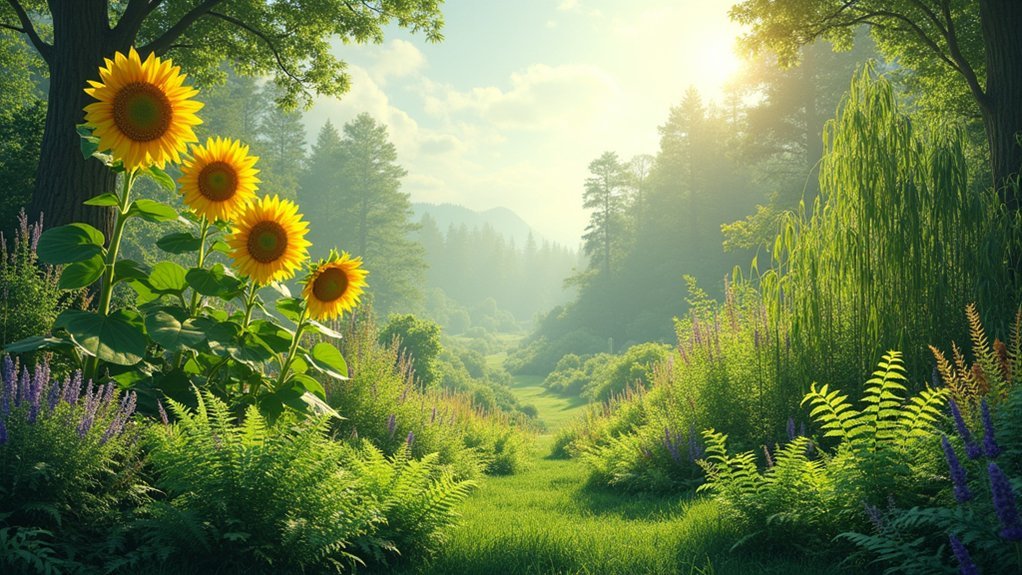

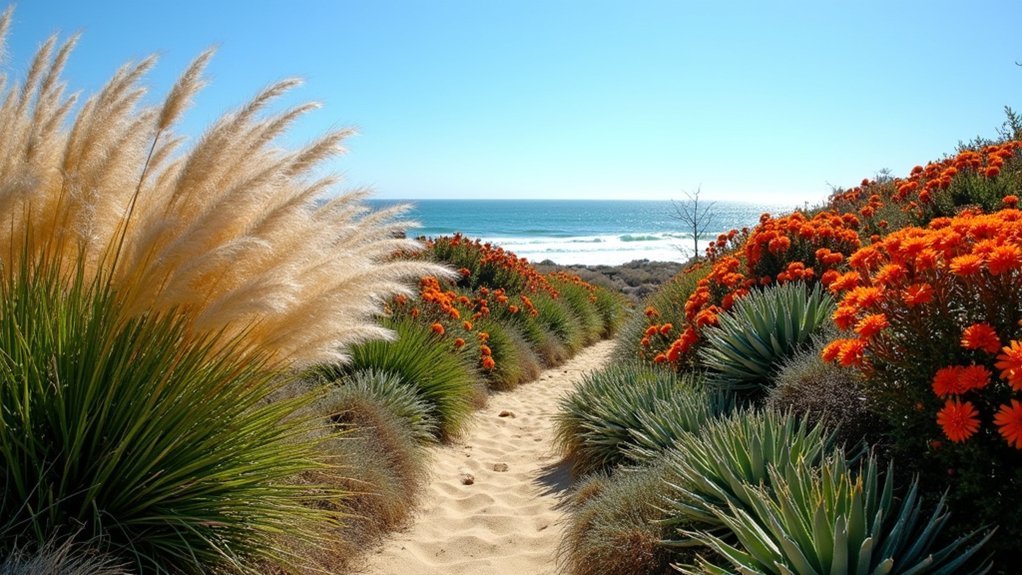
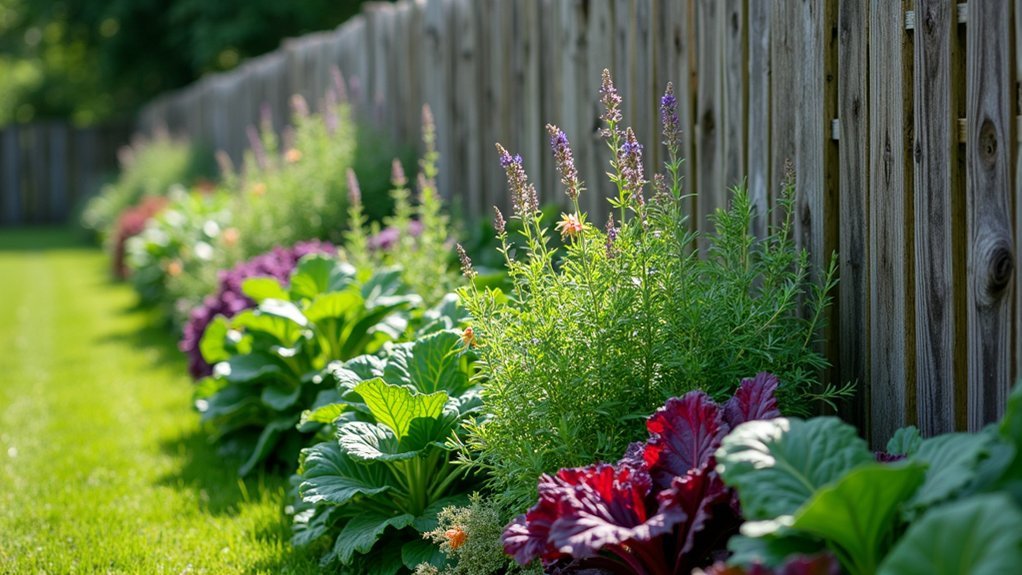
Leave a Reply